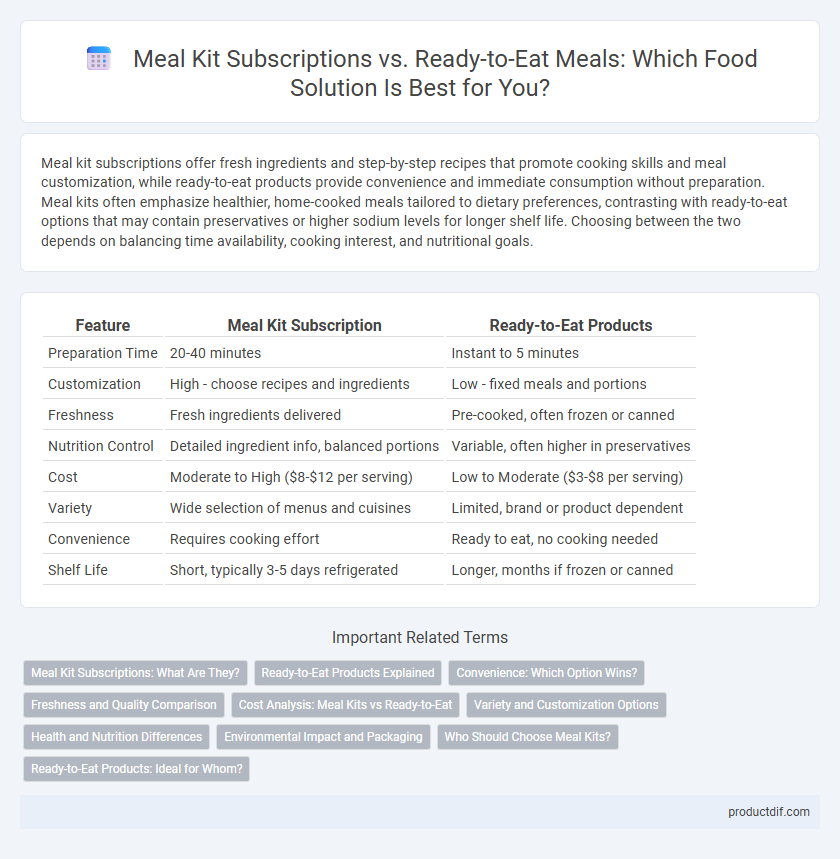Meal kit subscriptions offer fresh ingredients and step-by-step recipes that promote cooking skills and meal customization, while ready-to-eat products provide convenience and immediate consumption without preparation. Meal kits often emphasize healthier, home-cooked meals tailored to dietary preferences, contrasting with ready-to-eat options that may contain preservatives or higher sodium levels for longer shelf life. Choosing between the two depends on balancing time availability, cooking interest, and nutritional goals.
Table of Comparison
| Feature | Meal Kit Subscription | Ready-to-Eat Products |
|---|---|---|
| Preparation Time | 20-40 minutes | Instant to 5 minutes |
| Customization | High - choose recipes and ingredients | Low - fixed meals and portions |
| Freshness | Fresh ingredients delivered | Pre-cooked, often frozen or canned |
| Nutrition Control | Detailed ingredient info, balanced portions | Variable, often higher in preservatives |
| Cost | Moderate to High ($8-$12 per serving) | Low to Moderate ($3-$8 per serving) |
| Variety | Wide selection of menus and cuisines | Limited, brand or product dependent |
| Convenience | Requires cooking effort | Ready to eat, no cooking needed |
| Shelf Life | Short, typically 3-5 days refrigerated | Longer, months if frozen or canned |
Meal Kit Subscriptions: What Are They?
Meal kit subscriptions deliver pre-portioned ingredients and chef-designed recipes directly to your doorstep, offering a convenient way to cook fresh meals at home. These services prioritize meal variety, nutritional balance, and time-saving preparation, appealing to busy individuals seeking homemade food without extensive grocery shopping. Compared to ready-to-eat products, meal kits emphasize interactive cooking experiences and customized meal planning tailored to dietary preferences and lifestyle needs.
Ready-to-Eat Products Explained
Ready-to-eat products offer convenience by eliminating preparation and cooking time, making them ideal for busy lifestyles and instant consumption. These products often include pre-cooked meals, chilled or frozen, preserving flavors and nutritional value with extended shelf life through advanced packaging technologies. With increasing consumer demand for quick, portable food solutions, the ready-to-eat market is expanding rapidly across supermarkets and foodservice sectors.
Convenience: Which Option Wins?
Meal kit subscriptions offer the convenience of pre-measured ingredients with step-by-step recipes, reducing meal prep time while providing fresher, healthier options. Ready-to-eat products save even more time by eliminating cooking altogether, ideal for busy lifestyles or on-the-go consumption. For maximum convenience, ready-to-eat products typically win, but meal kits provide a balance between convenience and homemade quality.
Freshness and Quality Comparison
Meal kit subscriptions offer fresh, pre-portioned ingredients sourced directly from suppliers, ensuring high quality and superior taste in every meal. Ready-to-eat products often undergo preservative processes and packaging methods that can compromise freshness and nutrient retention. Consumers seeking optimal flavor and natural textures typically prefer meal kits over ready-made options due to their emphasis on fresh components and minimal processing.
Cost Analysis: Meal Kits vs Ready-to-Eat
Meal kit subscriptions typically cost between $8 and $12 per serving, offering fresh ingredients and customizable options, whereas ready-to-eat products range from $5 to $10 per meal but often come with higher preservatives and less nutritional value. The upfront investment in meal kits includes cooking time and potential ingredient waste, influencing overall cost-effectiveness. Consumers prioritizing convenience may find ready-to-eat meals more economical despite potentially sacrificing freshness and dietary control.
Variety and Customization Options
Meal kit subscriptions offer extensive variety and customization options, allowing customers to select meals based on dietary preferences, ingredient choices, and portion sizes. Ready-to-eat products provide limited variety and customization, often focusing on convenience and standardized meal options that cater to general tastes. The flexibility of meal kits supports diverse nutritional requirements and culinary exploration, whereas ready meals prioritize speed and simplicity over personalized dining experiences.
Health and Nutrition Differences
Meal kit subscriptions offer fresh, portion-controlled ingredients that support balanced nutrition and reduce reliance on preservatives commonly found in ready-to-eat products. Ready-to-eat meals often contain higher levels of sodium, sugars, and unhealthy fats, which can negatively impact long-term health. Choosing meal kits enables greater control over ingredient quality and macronutrient composition, promoting healthier eating habits.
Environmental Impact and Packaging
Meal kit subscriptions often generate less food waste by providing pre-portioned ingredients, reducing over-purchasing compared to ready-to-eat products that may contribute to higher waste due to single-use packaging and uneaten portions. Packaging for meal kits tends to use recyclable materials and bulk shipping methods, which lower overall carbon emissions, whereas ready-to-eat products frequently rely on plastic containers and excess packaging, increasing environmental footprint. Evaluating lifecycle assessments reveals meal kits generally have a smaller ecological impact, highlighting the importance of sustainable packaging innovations in both categories.
Who Should Choose Meal Kits?
Meal kits are ideal for individuals who enjoy cooking but seek convenience and want to improve their culinary skills with pre-portioned ingredients and step-by-step recipes. Busy professionals, health-conscious consumers, and those looking to experiment with diverse cuisines will benefit most from meal kit subscriptions. Unlike ready-to-eat products, meal kits offer freshness, customization, and a more engaging cooking experience.
Ready-to-Eat Products: Ideal for Whom?
Ready-to-eat products cater to busy professionals, students, and individuals with limited cooking skills seeking convenience without sacrificing taste. These products offer quick meal solutions, requiring minimal preparation and providing consistent quality through refrigeration or freezing technology. They are ideal for those prioritizing time efficiency and on-the-go lifestyles, delivering nutrition and variety without the need for extensive culinary effort.
Meal Kit Subscription vs Ready-to-Eat Products Infographic

 productdif.com
productdif.com